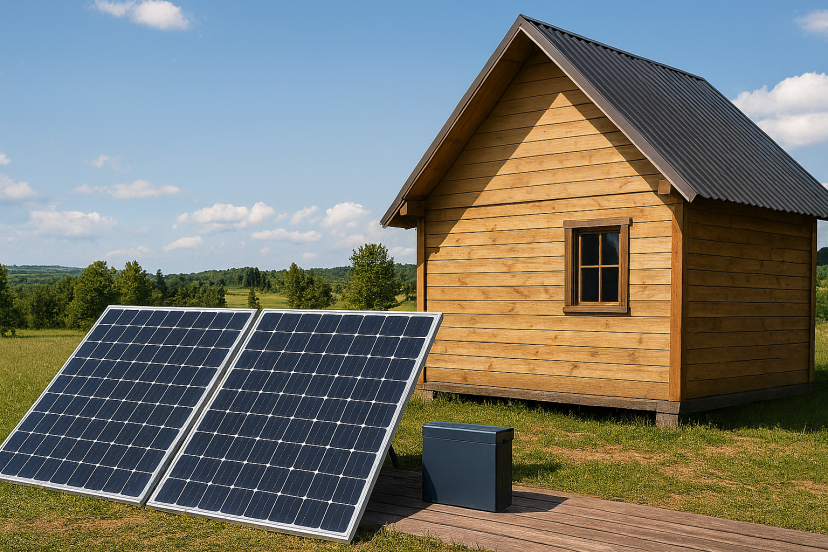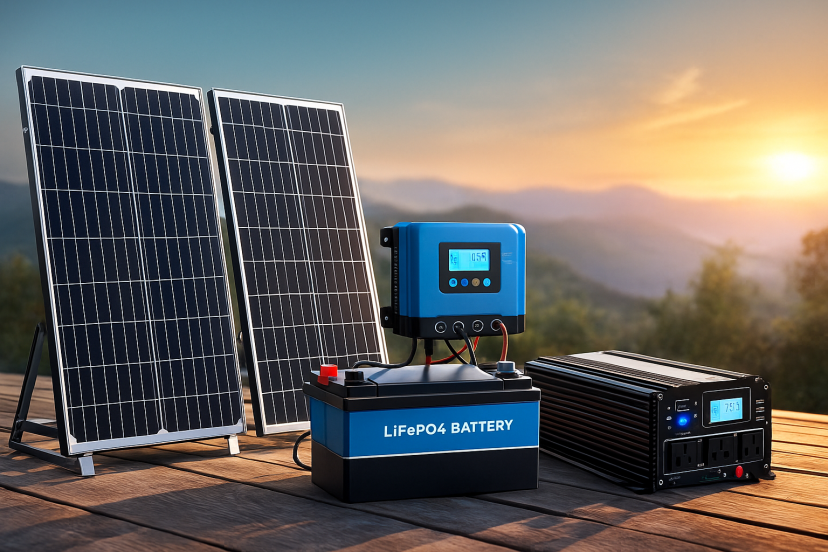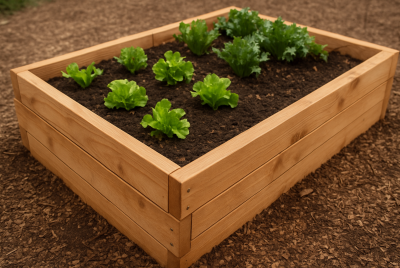Solar Power for Off Grid Living: Beginner’s Guide
We may earn a commission for purchases made using our links. Please see our disclosure to learn more.
Choosing solar power for off-grid living is one of the most reliable ways to achieve true energy independence. Solar gives you consistent daily power, low long-term costs, and the freedom to live far from utility lines without sacrificing comfort. With the right setup—properly sized panels, a dependable battery bank, and a quality inverter—you can run your home confidently using nothing but sunlight. This guide breaks down how off-grid solar works, what you need, and how to choose the right equipment so you can build a system that supports your lifestyle for years.
Why Solar Power Matters for Off-Grid Living
Solar is the backbone of most off-grid homes because it’s predictable, quiet, and incredibly low-maintenance. Once your panels are mounted and your equipment is sized correctly, the sun does the heavy lifting every single day.
Here’s why homesteaders trust solar over other energy sources:
- Fuel-free. No diesel deliveries, no gas cans, no ongoing costs.
- Scalable. You can start with a small array and expand as your needs grow.
- Long-lasting. Modern panels have 25-year warranties and often last much longer.
- Silent. No generator noise drowning out the birds or the creek next to your cabin.
- Works anywhere the sun hits. Remote location? Not a problem.
Solar gives you something priceless when you’re living off the grid: control over your energy.
How Off-Grid Solar Systems Actually Work
The idea of a solar system might seem complicated, especially when you hear words like “inverter” and “MPPT,” but the structure itself is surprisingly simple once you break it down.
You only need to understand four main components:
1. Solar Panels
Panels capture sunlight and turn it into usable electrical power. The best choice for off-grid setups is monocrystalline panels because they’re more efficient and offer higher energy output in limited space.
2. Charge Controller
This device acts like a smart traffic guard. It controls how much energy flows from your panels into your batteries. MPPT controllers are the gold standard because they maximize energy harvest—even during cloudy or fluctuating weather.
3. Battery Bank
Your battery bank holds the energy generated by your solar panels so you can use it anytime. Think of them as your homestead’s power reservoir. Lithium-iron phosphate (LiFePO4) batteries are ideal for off-grid systems since they deliver long life, stable output, and high efficiency.
4. Inverter
This transforms DC power from your batteries into usable AC power for your home. Most household appliances, tools, and electronics require AC—so a high-quality inverter is crucial.
When all four work together, you essentially have your own private power plant.

How Much Solar Power Do You Need?
This part intimidates almost everyone at first, but sizing your off-grid system becomes much easier when you follow a simple formula.
Here’s the beginner method:
- List every appliance or device you plan to run.
- Find their wattage (usually printed on a label).
- Estimate how many hours a day you’ll use each one.
- Add up the watt-hours from all your devices to see how much power you need each day.
- Determine how much energy you consume every day.
- Divide by your region’s peak sun hours.
- Add a 25–30% buffer for cloudy days and inefficiencies.
Example:
If your cabin uses 3,000Wh per day and you get 5 peak sun hours, you’ll need a solar array around 750W — ideally rounded up to 900–1,000W.
Most full-time off-grid homesteaders use 800W to 2,000W depending on lifestyle and appliances.
Choosing the Right Solar Panels for Off-Grid Homes
Panels are a long-term investment, so choose the ones that will stand up to harsh winters, windstorms, and direct sun.
Look for:
- Monocrystalline cells (more efficient than polycrystalline)
- 20%+ panel efficiency
- Aluminum frames & tempered glass
- 25-year warranty
- High load ratings for snow and wind
If you live in a snowy region or at high altitude, make load ratings your priority. If you live somewhere humid or coastal, corrosion-resistant frames matter more.
Batteries: The Heart of Your Off-Grid Power System
Your batteries decide how long your home can run when the sky turns gray. And when you’re off the grid, that’s something you’ll care about deeply.
Here’s what most homesteaders choose:
LiFePO4 Batteries
- Long lifespan (up to 10–15 years)
- High usable capacity
- Good performance in heat
- Safer than other lithium chemistries
Lead-Acid Batteries
- Cheaper upfront
- Lower lifespan
- Require more maintenance
- Less usable energy per cycle
Most off-grid homes benefit from a 200Ah to 600Ah lithium bank, depending on usage. If you plan to run a full-size refrigerator, power tools, or a well pump, aim on the higher end.
The Real Costs of Going Solar Off the Grid
While solar does have an upfront cost, it’s one of the few solar power for off grid living systems in your homestead that will pay you back over time.
Typical cost ranges:
- Small cabin: $1,200–$2,500
- Mid-size homestead: $3,500–$7,000
- Full off-grid home: $10,000+
Your battery bank and inverter will make up the bulk of your cost.
But here’s the key benefit:
Once you pay for the system, your electricity costs drop to almost zero.
That’s a luxury most grid-tied homeowners never get.

A Simple DIY Path to Start Your Off-Grid Solar Journey
If you’re not ready to build a massive system right away, start with something manageable. A small DIY kit teaches you the basics and helps you understand how energy flows through your home.
A beginner-friendly starter setup might include:
- 200–400W solar array
- 100Ah LiFePO4 battery
- 30–40A MPPT charge controller
- 1000W pure sine wave inverter
This is enough for lights, charging devices, running small appliances, and powering simple tools. Once you feel confident, add more panels and bigger batteries as your lifestyle demands grow.
Recommended Solar Products
Here are reliable options that homesteaders consistently use and trust:
1. Renogy 200W Monocrystalline Solar Panel Kit
Perfect for small cabins or starter setups.
2. ECO-WORTHY 400W Off-Grid Solar Kit
Includes solar panels, wiring, and a controller—budget-friendly and simple to set up.
3. LiTime 100Ah LiFePO4 Battery
A long-lasting, stable battery ideal for off-grid homes.
4. Renogy Rover 40A MPPT Charge Controller
Efficient and durable with a clear display for performance monitoring.
5. BESTEK 1000W Pure Sine Wave Inverter
A clean, consistent power source for sensitive electronics and daily use.
What Research Reveals About Off-Grid Solar Reliability and Performance
As more homesteaders adopt off-grid solar, scientists and energy researchers have been studying how these systems perform long-term. Their findings highlight both the strengths of solar technology and the practical considerations homesteaders need to keep in mind.
A major review published in Renewable and Sustainable Energy Reviews compared stand-alone solar setups with hybrid systems used across remote communities worldwide. The researchers found that stand-alone solar performs well in sunny, stable climates—but hybrid systems (solar plus wind or a small generator) offer better reliability in colder regions or areas with unpredictable weather. Their conclusion mirrors what many off-grid homeowners discover through trial and error: battery size, inverter quality, and backup power matter just as much as your solar panels when you rely on sunlight for daily living.
Another comprehensive review published in Sustainability investigated off-grid solar installations in rural communities and uncovered a surprising challenge: many systems failed early not due to poor hardware, but due to lack of maintenance and replacement planning. Some regions saw failure rates as high as 45–65% simply because batteries aged out with no replacement budget, wiring wasn’t protected from weather, or users weren’t trained on basic upkeep.
For homesteaders, this reinforces a simple truth—long-term success with solar depends not just on installing the system, but caring for it. Clean panels, healthy batteries, and routine system checks dramatically extend your solar system’s lifespan.
These studies highlight something encouraging: when off-grid systems are properly maintained and well-sized, they’re incredibly reliable. Solar isn’t guesswork—it’s a proven technology backed by decades of research.
Tips to Make Your Solar System Last Longer
Once you’re relying on the sun for your power, you’ll naturally develop habits that help your system thrive.
Here are a few that go a long way:
- Clean your panels every few months to prevent dust buildup.
- Mount your panels securely to avoid shading from nearby trees.
- Protect your wiring from moisture, rodents, and weather exposure.
- Check battery voltages and pay attention to performance trends.
- Keep batteries warm in winter and cool in summer when possible.
You don’t need to hover over your system. Just treat it like any other essential homestead tool—maintain it consistently and it will serve you for years.
Conclusion
Solar power remains one of the most dependable foundations for off-grid living. With the right mix of panels, batteries, and system planning, you gain a stable energy source that supports your homestead long-term—especially when paired with other self-sufficiency projects like building your own raised beds. With a well-designed solar setup and a few core skills, you’ll have everything you need to build a more independent and sustainable lifestyle.
FAQs
1. How many solar panels do I need to live off the grid?
Most small cabins operate comfortably on 800W–2000W of panels, depending on climate and daily usage.
2. Can I use solar power to run a refrigerator?
Yes—just make sure you have a strong battery bank and an inverter of at least 1500–3000W.
3. Are lithium batteries worth it?
Definitely. LiFePO4 batteries last longer, offer more usable energy, and require less maintenance.
4. Do solar panels function while it’s cloudy outside?
They do—at reduced efficiency. A larger battery bank helps bridge cloudy days.
5. Can I set up the system on my own?
Many homesteaders do. Start with a small kit, learn the basics, and expand when you’re ready.




